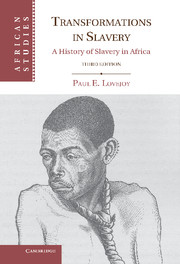Book contents
- Frontmatter
- Contents
- Maps and Tables
- Note on Currencies, Weights, and Measures
- Preface
- Preface to the Second Edition
- Preface to the Third Edition
- 1 Africa and Slavery
- 2 On the Frontiers of Islam, 1400–1600
- 3 The Export Trade in Slaves, 1600–1800
- 4 The Enslavement of Africans, 1600–1800
- 5 The Organization of Slave Marketing, 1600–1800
- 6 Relationships of Dependency, 1600–1800
- 7 The Nineteenth-Century Slave Trade
- 8 Slavery and “Legitimate Trade” on the West African Coast
- 9 Slavery in the Savanna during the Era of the Jihads
- 10 Slavery in Central, Southern, and Eastern Africa in the Nineteenth Century
- 11 The Abolitionist Impulse
- 12 Slavery in the Political Economy of Africa
- Epilogue
- Appendix Chronology of Measures against Slavery
- Notes
- Select Bibliography
- Index
- Books in this series
6 - Relationships of Dependency, 1600–1800
Published online by Cambridge University Press: 05 June 2012
- Frontmatter
- Contents
- Maps and Tables
- Note on Currencies, Weights, and Measures
- Preface
- Preface to the Second Edition
- Preface to the Third Edition
- 1 Africa and Slavery
- 2 On the Frontiers of Islam, 1400–1600
- 3 The Export Trade in Slaves, 1600–1800
- 4 The Enslavement of Africans, 1600–1800
- 5 The Organization of Slave Marketing, 1600–1800
- 6 Relationships of Dependency, 1600–1800
- 7 The Nineteenth-Century Slave Trade
- 8 Slavery and “Legitimate Trade” on the West African Coast
- 9 Slavery in the Savanna during the Era of the Jihads
- 10 Slavery in Central, Southern, and Eastern Africa in the Nineteenth Century
- 11 The Abolitionist Impulse
- 12 Slavery in the Political Economy of Africa
- Epilogue
- Appendix Chronology of Measures against Slavery
- Notes
- Select Bibliography
- Index
- Books in this series
Summary
In the seventeenth and eighteenth centuries, there were a variety of slave regimes in Africa. At one extreme, in many places in the far interior and in isolated spots between the major states and trade corridors, slaves were still marginal to society, forming one category of dependents in kinship systems but ultimately having little structural impact on the local economy or society. Other regions along the Atlantic coast had more slaves, although the outlook toward slavery was still in terms of dependency, even though the impact of the European market provided a situation in which slavery changed. From Sierra Leone in the west to Angola in the south, slavery was transformed as the interaction between enslavement, trade, and slave use influenced the organization of society. In some places, slavery was the basis for a mode of production; in a few areas, this productive system dominated the social formation. Two broad zones emerged: one strongly Islamic in the savanna belt, where there was a continuation and consolidation of earlier patterns of slave use and supply; and a second that was rooted in the tradition of kin-based societies that were now experiencing the transformation to slave societies. A final feature of this continuum of slave regimes was the foundation of European settlements where slave use shared some of the features of slavery in the Americas. These settlements were one bridge between the European-controlled productive regime in the Americas and the African-controlled system of slave supply.
The Expansion of Slavery
The external demand for slaves and the rivalry between African states directly affected the spread of slavery, for both caused tensions that led to the enslavement of people. The economy became dependent on exports to satisfy the personal desires of merchants and rulers and to provide many parts of Africa with a money supply, textiles, firearms, and other goods essential to the economy and political rule. The fragmented political structure, reinforced by military purchases and the need to acquire slaves to finance imports, was related to a general state of insecurity that facilitated enslavement. These two conditions – the slave market and institutionalized enslavement – set the stage for the course of slavery in Africa.
- Type
- Chapter
- Information
- Transformations in SlaveryA History of Slavery in Africa, pp. 108 - 134Publisher: Cambridge University PressPrint publication year: 2011

